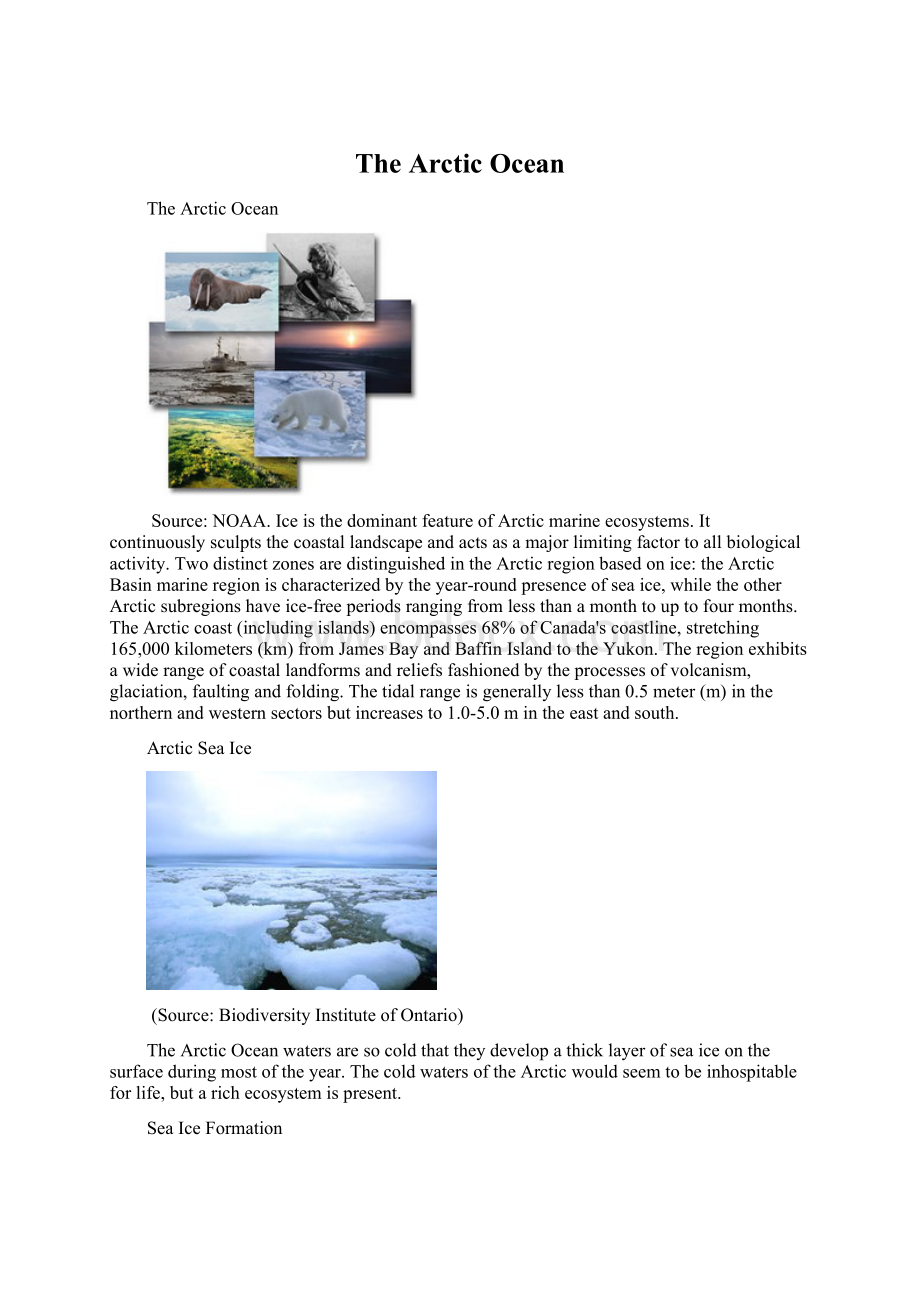The Arctic Ocean.docx
《The Arctic Ocean.docx》由会员分享,可在线阅读,更多相关《The Arctic Ocean.docx(19页珍藏版)》请在冰豆网上搜索。

TheArcticOcean
TheArcticOcean
Source:
NOAA.IceisthedominantfeatureofArcticmarineecosystems.Itcontinuouslysculptsthecoastallandscapeandactsasamajorlimitingfactortoallbiologicalactivity.TwodistinctzonesaredistinguishedintheArcticregionbasedonice:
theArcticBasinmarineregionischaracterizedbytheyear-roundpresenceofseaice,whiletheotherArcticsubregionshaveice-freeperiodsrangingfromlessthanamonthtouptofourmonths.TheArcticcoast(includingislands)encompasses68%ofCanada'scoastline,stretching165,000kilometers(km)fromJamesBayandBaffinIslandtotheYukon.Theregionexhibitsawiderangeofcoastallandformsandreliefsfashionedbytheprocessesofvolcanism,glaciation,faultingandfolding.Thetidalrangeisgenerallylessthan0.5meter(m)inthenorthernandwesternsectorsbutincreasesto1.0-5.0mintheeastandsouth.
ArcticSeaIce
(Source:
BiodiversityInstituteofOntario)
TheArcticOceanwatersaresocoldthattheydevelopathicklayerofseaiceonthesurfaceduringmostoftheyear.ThecoldwatersoftheArcticwouldseemtobeinhospitableforlife,butarichecosystemispresent.
SeaIceFormation
(Source:
BiodiversityInstituteofOntario)
Saltlowersthefreezingtemperatureofwater,sothatseawaterfreezesatabout-2°C,whereaspurewaterfreezesat0°C.WhentheairtemperaturedropsintheArctic,athicklayerofseawaterbecomesreadytofreezeallatonce.Thefirstsignsoffreezingarechangesincolorandtextureasmillionsoftinyfloatingiceneedlesform,creatingadense“soup”calledfrazilice.Asthetemperaturefallsfurther,thefrazilicethickensandtrapspocketsofsaltyseawater,orbrine,withinitslayerscreatingaslushymixturecalledgreaseice.Eventuallythegreaseiceaccumulates,reachingathicknessofupto1m.Inresponsetogravity,thepocketsofbrinemovedownward,andwithinafewweeksaccumulateinthelowerlayers.Asaresulttheiceatthesurfacecontainslittlesalt.Theirremovalfromtheupperlayersincreasesitsfreezingpoint,aidingthechangefromgreaseicetosolidice.Seaicethusfreezessolidfromthetoplayerdown.Eventually,allofthesaltwaterisdrainedandtheicelayerisfrozensolidintopackice.Duringthewinter,theareaoftheArcticOceancoveredwithpackiceexpandstoformacontinuousvastsheet.Whenmeltingoccursinthespringandsummer,thepackiceretreatsandbreaksupintosmallerpieces.
(Source:
BiodiversityInstituteofOntario)
TypesofSeaIce
TherearetwoformsofpackiceintheArctic.Thewintericepackconsistsofannualice,whichmeltsinthespringandfreezesagaininthefall.Multiyearice,whichremainsfrozenthroughoutthesummer,formsfarthernorthintworegions:
InthecentralpartoftheArcticOcean,thereisthemassivepermanentpolarpack,otherwiseknownastheArcticorpolaricecap,thatslowlyrotatesclockwiseasaunit.Thesummericepack,whichmakesuptheotherregionofmultiyearice,surroundsthepermanentpolarpack,andbreaksupinthesummer.ThesebrokenpiecesoficeblockmanyofthechannelsbetweentheArcticislandsyear-round.
(Source:
BiodiversityInstituteofOntario)
MultiyearIce
(Source:
BiodiversityInstituteofOntario)
Multiyeariceremainsfrozenyear-round,butstillgoesthroughacycleofchanges.Thesurfacelayerofthisicemeltsinthesummerandthewaterthendrainsthroughporesintheicetothebottom.Thissalt-freemeltwaterremainsfloatingbeneaththeiceatopthedensersaltwater.Inthewinter,themeltwaterrefreezesasalayeronthebottomofthepackice.Oneyearatatime,thelayerstravelupwardinacontinuouscycleoflossandreplacement.Thiscyclepreventsthemultiyearicefromthickeningindefinitely.MultiyeariceformsthepermanentpolarpackinthecenteroftheArcticOcean,aswellasthesummericepackthatsurroundsthepermanentpolaricepack,andbreaksupinthesummer.Unlikeannualice,thesummericepacknevercompletelymelts.
AnnualIce
(Source:
BiodiversityInstituteofOntario)
Annualicetypicallyreachesathicknessofabout2metersoverthewinter.ThistypeofpackicebeginstoformbythemiddleofSeptember,andbytheendofOctobertheicefieldisalmostsolidalongthecoasts.Aswinterprogresses,theannualiceextendsoffshore,connectingsomeislandswithasolidsheetofseaice.ThethicknessoftheiceincreasesuntilMayatwhichpointitbeginstothaw,withshallowbluepoolsformingontheicesurface.Risingsummertemperaturescausetheicetomeltfurtherandeventuallyitbreaksup.Cracksformthatsoonwidenintochannelsorleadsthatseparatetheicepackintochunkscalledfloes.Floessometimescollidewitheachother,andbreakintomanypieces.IcebreakupoccursinearlyJulyinthelowArctic,andattheendofthemonthinthehighArctic.TheicedensitydeclinesuntillateAugust,butbymid-Septemberthefreezingcyclebeginsagain.
(Source:
BiodiversityInstituteofOntario)
Segmentsoftheicepackthatarefirmlyfrozentotheshoreareknownaslandfastice.Offshorewindspushiceawayfromthecoastcreatingagapofopenwaterbetweenthelandfasticeandthepackice-ashorelead.Thewindsalsopushthepackicefurtherouttosea,causingthedriftingfloestocollideandrideupovereachother,orhummock.Theresultisadistinctridgeofjumblediceblocks.
Theloose,floatingpiecesoficepresentinthesummerscourtheshorelines,preventingmostplantsandanimalsfromsettlinginshallowwater.Thismakestheintertidalzone,theareabetweentheshorelineandthenearshorebottom,muchmorebarrenthanitisinothermarineecosystems.
WheretoFindArcticSeaIce
About12-13millionsquarekilometersoftheArcticBasinarecoveredbyiceinwinter.AdditionalseaicecoversmuchofBaffinBayandHudsonBay,aswellastheLabradorSea.NearlyalloftheArcticandsub-Arcticshoresareice-boundthroughoutthewinter.Bylatesummer,theamountofArcticseaiceisreducedtoabout9millionsquarekilometers.Duringthisseason,loosepackicefromtheArcticmovessouthwardalongtheeastGreenlandcoastandfromBaffinBaydowntheLabradorcoastintothenorthAtlanticOcean.Althoughlanesofwateropeninthesummeralongthemainland,manyofthechannelsintheCanadianarchipelagoremainice-cloggedyear-round.
Polynyas
(Source:
BiodiversityInstituteofOntario)
Apolynyaisalargeareaofopenwatersurroundedbyseaicethatisfoundinthesameregionyearafteryear.Althoughpolynyascanbehundredsofkilometerswide,theirsurfaceareaisfarlessthantheareaofseaicewhichsurroundsthem.However,theopenwatersofpolynyasareveryimportanttolifeintheArcticOcean.Polynyasteemwithanimalandplantlife.Itisonlyhere,wheretheseaiceisabsent,thatthesun’senergydirectlyreachesthewaters.Snowandiceordinarilyreflectmuchofthesun’slightenergy,buttheopenwatersofpolynyasabsorbit.Phytoplanktoninthepolynyausethisenergytoproduceanutrientrichgrazingareaforzooplankton.Feedingonthesesmallanimalsarewhalesandfishesthatinturnfeedseals,walrusesandpolarbears.OftenseenasoasesintheharshclimateoftheArcticmarineenvironment,polynyashaveintriguedscientistsformorethanacentury.
Formation
(Source:
BiodiversityInstituteofOntario)
Polynyasoccurinareaswhereswiftlymovingseacurrentspreventthefreezingofsurfacewater.Manypolynyasaresmall,measuringonlyafewhundredsquarekilometers,andmayfreezeoverattheheightofwinter.Thelargerpolynyas,however,stayopenallwinter,althoughtheymayshrinkinsizeinextremelycoldtemperatures.Adistinctcharacteristicofallpolynyasisthattheyarerecurrent.ThelargestArcticpolynya,NorthWater,occursattheheadofBaffinBay,andislikeaninlandseasurroundedbyice.Thispolynyawasdiscoveredin1616,andisusuallyaboutaslargeasLakeSuperior!
Comparedtothesurroundingair,thewatersofapolynyaaresowarmthatsteambillowsup.Theaveragetemperatureofthewaterswithinapolynyaisabout0°C,anditneverdipsbelow-2°C,thefreezingpointofseawater.Polynyasallowheatfromwarmoceancurrentstoescape;thisisimportantintheregulationoftheEarth’stemperature.
Incalmweather,alayerofnewicecanformacrossapolynyainminutes.Inevitably,astrongwindorwavesmashesthisnewicelayer,drivingitouttoseaandonceagainopeningthesurfaceofthepolynya.Thisprocessoccursrepeatedly,makingpolynyasanimportantsourceofnewArcticseaice.
Leads
(Source:
BiodiversityInstituteofOntario)
Aleadisafractureorlargecrackintheseaicethatresultsinapassagewayofopenwater.Leadsarelessimportanttosealifethantheopenareasofpolynyas,buttheyarestillimportanttomanyorganisms.Leadsprovideimportantarteriesforthenavigationofmarinemammalsandbirds.
Leadscanoccuralmostanywherethatseaiceispackedrelativelyloosely.Theymayappearsuddenly,andtendtoopenandcloseoveraperiodofjustafewhoursfollowingchangesinwindsortides.Thereareplaces,however,wherewide,predictableleadsformbetweenthelandfasticeandthefree-floatingpackice.Theselong-lastingleadsarecreatedbywindsblowingoffshorethatpushiceawayfromthecoast,causingthepackicetoaggregate.Thesedistinctleadsprovideopenwaterfornewiceformation.
Leadscanoftenbedetectedfromagreatdistancebecausetheymakethecloudsabovethemappeardark.Thisoccursbecausetheopenwaterinleadsabsorbssunlight,whichisnormallyreflectedofficeorsnow.Thiscausesadarkstreaktoappearontheunderside